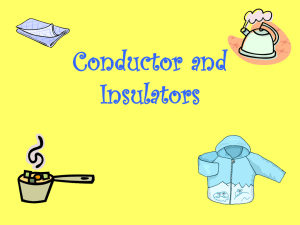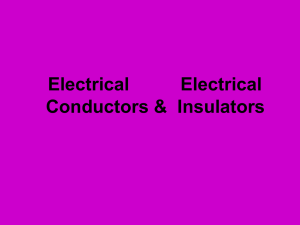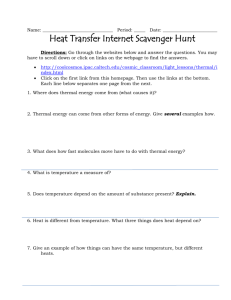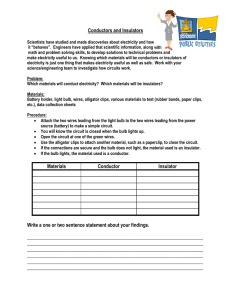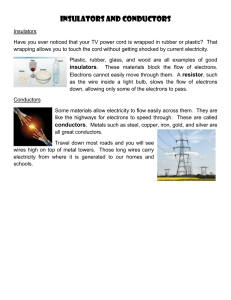Electrical Conductors & Insulators Worksheet - Grade 6
advertisement
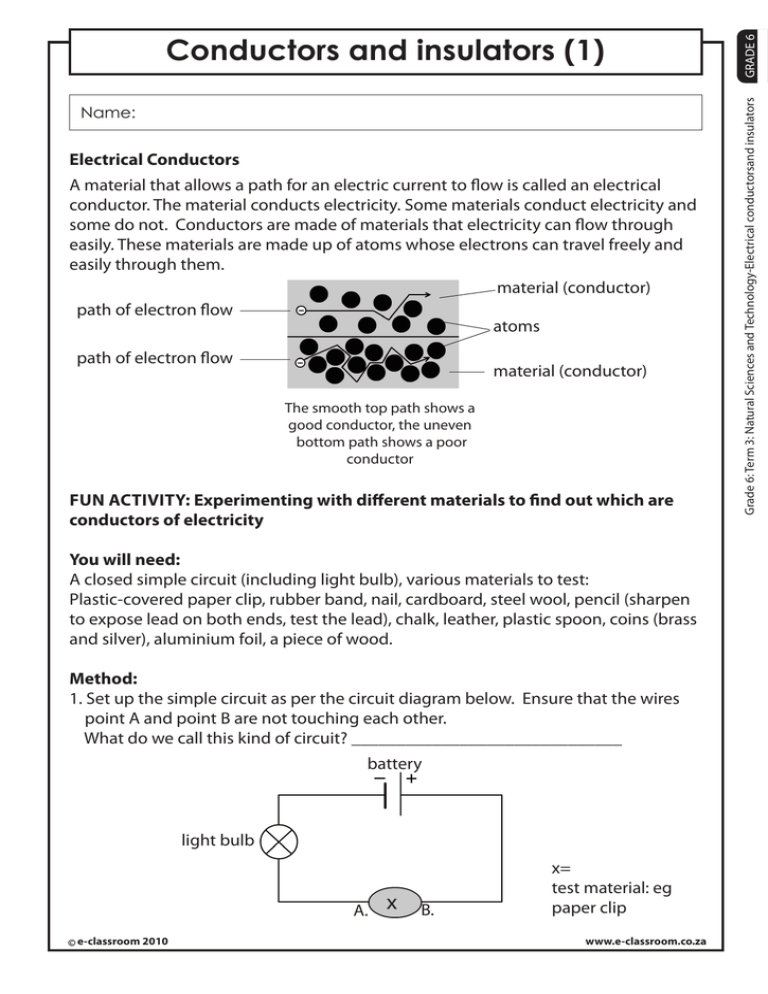
Name: Electrical Conductors A material that allows a path for an electric current to flow is called an electrical conductor. The material conducts electricity. Some materials conduct electricity and some do not. Conductors are made of materials that electricity can flow through easily. These materials are made up of atoms whose electrons can travel freely and easily through them. material (conductor) path of electron flow atoms path of electron flow material (conductor) The smooth top path shows a good conductor, the uneven bottom path shows a poor conductor FUN ACTIVITY: Experimenting with different materials to find out which are conductors of electricity You will need: A closed simple circuit (including light bulb), various materials to test: Plastic-covered paper clip, rubber band, nail, cardboard, steel wool, pencil (sharpen to expose lead on both ends, test the lead), chalk, leather, plastic spoon, coins (brass and silver), aluminium foil, a piece of wood. Method: 1. Set up the simple circuit as per the circuit diagram below. Ensure that the wires point A and point B are not touching each other. What do we call this kind of circuit? ______________________________ battery light bulb A. x B. ©e-classroom 2010 x= test material: eg paper clip www.e-classroom.co.za GRADE 6 Grade 6: Term 3: Natural Sciences and Technology-Electrical conductorsand insulators Conductors and insulators (1) 2. Test that the circuit is working by touching ends A and B together (the light bulb will light up). 3. Take the first of the objects you have and place it between the two wire ends at A and B. Make sure that there is good contact between the object and the wire end. Does the light bulb light up or not? 4. Record your findings in the table below. Material Bulb lights up Bulb does not light up Plastic-covered paper clip Rubber band Nail Cardboard Steel Wool Pencil (test lead) Chalk Leather Plastic spoon Coins (brass and silver) Aluminium foil Piece of wood Findings: What do the materials that light up the bulb have in common? What do the materials that don’t light up the bulb have in common? Most metals are conductors of electricity: Copper: Silver: Copper is the most common material used for wiring Is the best conductor (meaning that it is material which makes it the ©e-classroom 2010 www.e-classroom.co.za GRADE 6 Grade 6: Term 3: Natural Sciences and Technology-Electrical conductorsand insulators Conductors and insulators (2) easiest for current to flow through) but silver is expensive, so very rarely used in wiring. Gold: Does not rust, is expensive and is only used when high-quality contacts are needed. Aluminium: Is not a very good conductor but sometimes it is used where weight is a consideration. It is not as heavy as copper. All conductors allow current to flow through them if there is enough electrical energy, but normally the energy is too low. Electricity will always take the shortest path to the ground. Your body is made up of 60% water and that makes you a good conductor of electricity. If a tree has fallen on a power line and you touch the tree, you will become the path or conductor to the ground and can be electrocuted. Trees are also good conductors of electricity. That is why you never stand under a tree when lightening strikes. Electrical Insulators An insulator does not allow for the free flow of an electrical current. Plastic Insulator Plastic Insulator Ceramic Insulator Conducting Materials (Copper) Insulating Material (plastic) Look at the pictures above. Can you see that the wires are wrapped in a plastic sheath or ceramic material? The plastic/ ceramic cover acts as the insulator. Can you answer the following questions: 1. What is the function of an insulator? 2. Conductors and insulators are opposites, so a good conductor is a insulator and a good insulator is a conductor. 3. Why do you think rubber gloves and shoes will protect you from a mains ©e-classroom 2010 www.e-classroom.co.za GRADE 6 Grade 6: Term 3: Natural Sciences and Technology-Electrical conductorsand insulators Conductors and insulators (3) electrical current shock, but not from a lightning bolt? 4. Electrical Insulators are also used in other places. Can you think of three other places that you would find insulators? 5. Why do you think birds don’t get electrocuted if they sit on power lines or telephone poles? (hint: think of the material that they are made from) 6. Look at the picture of the light bulb. Why do you think thepiece separating the electric metal pins (conductors) is made of glass? Pin Glass Key learning points: l Some materials allow electric current to flow through them. These are called conductors. l Some materials do not allow electric current to flow through them. These are called insulators l Metals are usually conductors and non-metals are usually insulators l Plastic and ceramics are insulators and therefore prevent you from getting a shock KEY WORDS electrical conductors materials electrons electrical current ©e-classroom 2010 insulators www.e-classroom.co.za Grade 6: Term 3: Natural Sciences and Technology-Electrical conductorsand insulators GRADE 6 Conductors and insulators (4)

